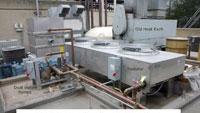IOT cooling contamination
Advances in inductive output tube design have allowed IOTs to continue to operate up to and beyond 80,000 hours. Although some IOTs fail much sooner for a variety of reasons, most will live a long life when properly cared for. Defects in the internal structure of the tube have become rarer these days, but that’s not the only thing that can cause a tube failure. Improperly maintained voltages can shorten an IOT’s life span, so can inadequate high-voltage protection and contaminates in the cooling system. When not properly maintained, a dirty cooling system can kill a perfectly good IOT and throw the capital budget out of whack. This type of failure does happen from contaminates in the cooling liquid, which in most cases means glycol.
Liquid cooling
Glycol, basically an alcohol-based heat-transfer fluid, is the liquid often used today in cooling IOT transmitters. Several main suppliers provide both ethylene and propylene glycol, but two of the more commonly used glycols are Ucartherm and Dowtherm SR-1, both from Dow Chemical. Besides transferring heat, they also perform another very important function: inhibiting corrosion of the pipes internal and external to the tube. Another important feature is their ability to prevent pipes from bursting when freezing weather sets in, which can cause quite a problem because the easiest place for those pipes to burst is in the radiators, requiring the entire radiator to be changed.

But once the transmitter has been installed and it’s running, there can be a tendency to forget about the transmitter’s coolant. Just like an automobile, its fluids need periodic checking. About once a year, the transmitter’s cooling fluid should be tested. In the past, some engineers would just check the specific gravity of the cooling fluid and top it off with more glycol if it was low. Today, an entire battery of tests can be performed on a transmitter’s coolant to give a much better idea of what is going on inside a cooling system. Most suppliers will do the testing for a fee. (It used to be free if you bought their product, but they do at least give you a comprehensive report.)
As you can see, in Figure 1 (pdf), the concentration of glycol is OK and the corrosion inhibitors are within limits. This report even gives recommendations on what action, if any, should be taken.
If any of the parameters are not within the stated limits, this particular report would advise adding certain compounds to correct this. But most transmitter and tube manufacturers will now advise you to replace the cooling fluid instead, which is easier said than done. The reason for this is cost: The few hundred dollars it costs to replace the glycol is small compared to the cost of a tube if it fails due to the breakdown of the coolant, and no one wants to take that responsibility.
With today’s environmental regulations and laws, it’s much harder and costly to dispose of transmitter cooling fluid than in the past. Back then, you could just open a valve and let it run down the drain; today, that would be very irresponsible and is illegal. Even when the transmitter site is far off on a mountain top, just letting it run out on the ground can injure or kill wildlife.
Get the TV Tech Newsletter
The professional video industry's #1 source for news, trends and product and tech information. Sign up below.
In California, you need to obtain a temporary EPA license and then arrange with a disposal company to come take the glycol away in 55g drums.
Don’t forget to check and clean the heat exchange radiators — look underneath and remove any leaves or other debris that has been sucked up by the fans. It’s also recommended that the thermostats for the fans be adjusted, so every year the first fan to turn on (which is the one running most of the time) will be rotated. This is a notable point, because over the years that last fan may be needed, and you won’t know if it works if it never turns on under normal conditions. (See Figure 2, above.)
The same holds true for the water pumps. They should be rotated at least every couple of months or, even better, at the monthly log readings. This way, it’s easy to see if one pump has failed before it’s needed.
Air cooling
Even liquid-cooled transmitters use air to do some of the cooling. RF components like the output stack, solid-state IPAs, input cavity and power supplies are best cooled by air. All transmitters have air filters at the air intake for these fans, which should be cleaned regularly. Some transmitter rooms are sealed off from outside air and just recirculate the conditioned air within the room; these are the cleanest rooms without outside dust and dirt getting into the transmitter. But still, the air filters must be checked and cleaned on the transmitter.
A good example of why the air filters should be cleaned happen when an IOT that had been working for several years suddenly developed a high-voltage problem where it would not hold up anymore. As soon as high voltage was applied, it would crowbar. It was thought that the tube had failed and a new one was on order, but when the old one had its input cavity removed, the problem was revealed.
It seems some type of contaminate had worked its way between the silicon boots that surround the ceramic gun insulator found at the bottom of the input cavity. This contaminate allowed an arc path to develop between the grid ring (~34kV) and the IOT’s pole piece (grounded). (See Figures 3, previous page, and 4.)
Once the first arc occurred, the carbon created on the silicon boot made it that much easier for the next arc to occur. It looked much worse than it was. Once the silicon was cleaned and the arc pitting was sanded down, they were as good as new. (See Figure 5.) Both the input cavity and IOT were “high-potted,” tested with high voltage, and they both passed. (See Figure 6.) The input cavity was not suspected because the quality of input cavities has improved greatly over the years. In the early days of IOTs for television, there was a great deal of trouble with the input cavities — but that is in the past. In this case, the culprit was some type of contaminate that got past the air filters.
As in all high-voltage systems, cleanliness is the best way to staying on the air. By keeping both the cooling liquid and air clean, transmitters will last longer and have fewer problems.
The next “Transition to Digital” will continue with transmitter coolant contamination issues.
Have comments or questions about this article? Leave a comment or visit our Forum and start a discussion.
You can also find a complete list of past “Transition to Digital” tutorials here.












